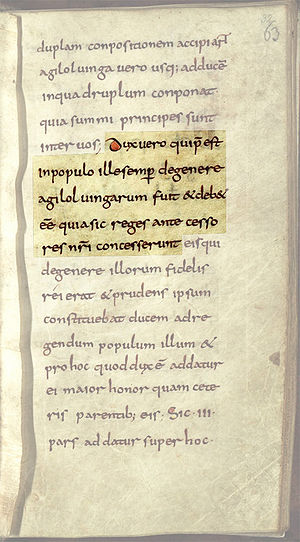
The Bavarian dukes until the fall of Duke Tassilo III in 788 are called the Agilolfings. This is based on the provision by the Lex Baioariorum that the dukes must always belong to this dynasty. However, there are no confirming sources. Nor are all the early dukes known by any means, due to the incomplete nature of the tradition. The question of the origin of the Agilolfings can hardly be answered, since the social elite in the early Middle Ages was connected and related beyond borders. Their "family name" makes it clear that the Agilolfings belonged to these highest circles. Such names, probably derived from a first ancestor, usually only appertained to royal families in the early Middle Ages. The Agilolfings entered into various marriages with such families, especially those of the Lombard and Frankish realms, and even provided Lombard kings. Individual early sources, which assign the title of king to the Bavarian dukes themselves, cannot be verified in their factuality, but they did establish a concept of history which was still referred to in 1806 by Elector Max IV Joseph (ruled 1799-1825, from 1806 as King of Bavaria) in his proclamation as King.
The name "Agilolfings"
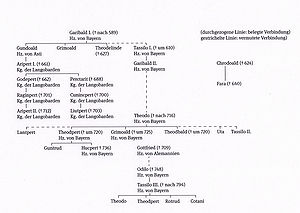
Since the 17th century, historiography has referred to the Bavarian dukes of the early Middle Ages as Agilolfings. This is based on a provision by the Lex Baioariorum (III, 1) with the following content, formulated from the point of view of the Frankish king: "But the duke, who is at the head of the people, has always been of the Agilolfing lineage and must be, because our predecessors as kings assured them that they would appoint one of their own lineage, who was loyal to the king and wise, as duke to rule this people". However, this statement should not be taken at face value: The Lex Baioariorum, as its handwritten tradition shows, was known and widespread in Bavaria until the 13th century, and during this period there were numerous dukes who clearly did not belong to the Agilolfing family. Legal claim and reality obviously diverged here and this possibility must also be reckoned with in the early Middle Ages. For the Bavarian dukes of the 6th to 8th century, there is not a single source besides the Lex that would confirm their affiliation to a dynasty called "the Agilolfings". Moreover, the genealogical connection between them can only be reconstructed with great gaps and uncertainties. That the dukes all came from the same dynasty and that this dynasty came to an end with the deposition of Tassilo III (ruled 748-788) or with the forced entry of his children into a monastery at the same time, is therefore a plausible assumption based on the provision of the Lex, which cannot be ultimately confirmed though. What also remains unknown is the differentiation of the family from others and how the individuals saw themselves, i.e. the question of whether all the people who are called Agilolfings really considered themselves as such. It is therefore advisable to understand the name "Agilolfings" merely as a practical auxiliary term, under which the Bavarian dukes can be subsumed.
Origin
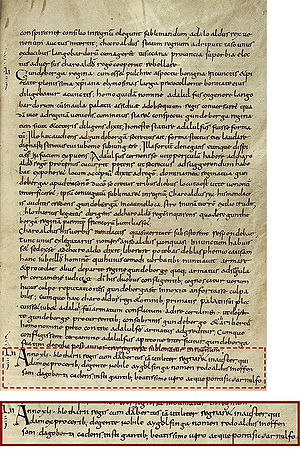
The name is derived, as one may assume, from an actual or even only supposed first ancestor called Agilolf (or similar). Various suggestions have already been made for the identification of this person, for example with the Suebian king Agilulf (died 457) or with the Lombard king Agilulf (590-615/16; ruled 591-615/16), but all these attempts remain highly uncertain. In any case, the name does not appear among the family members known to us. In view of the fluctuating conditions during the Migration Period, the ethnic classification of the dynasty cannot be clearly determined, especially since it was common practice in the higher aristocratic circles to marry across borders. The first known Bavarian Duke Garibald I (died ca. 590) belonged to the entourage of the Frankish king ("unus ex suis": Paulus Diaconus, Historia Langobardorum I, 21), and his daughter Theudelinde (died 627) is expressly stated to have come "from a Frankish dynasty" ("ex genere Francorum": Fredegar, Chron. IV, 34) ). Outside Bavaria, the nobles Chrodoald (died 624) and Fara (died 640), active in the Frankish Rhineland, are mentioned as being "from the noble Agilolfing dynasty" ("de gente nobile Ayglolfingam": Fredegar, Chron. IV, 52), and in 756 Abbot Wicpert of St. Martin in Tours dies, who is said to have been a bishop from Bavaria and "of Agilolfing descent" ("genere Heilolvingus": Ann. Petaviani, 18). How these men known as Agilolfings are related to the simultaneously known dukes of Bavaria remains uncertain, for "where we have news of the early Bavarian dukes, there are no Agilolfings, and where we have news of Agilolfings, there are no Bavarian dukes" (Carl I. Hammer).
High rank
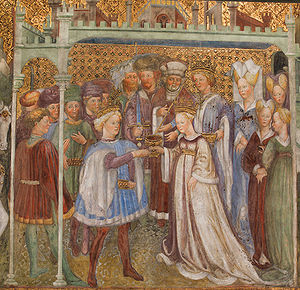
The mere fact that they are named with a common "family name" (which is extremely rare in the early Middle Ages) is a sign of the Agilolfings' outstanding position. From their first known appearance in the 6th century onwards, the Bavarian dukes who were counted among them belonged to the highest aristocratic class in Europe, as can be seen especially from their marriage ties with other princely families. For example, Bavarian Duke Garibald I married Lombard Princess and former Frankish Queen Waldrada, their daughter Theudelinde was to be married to Frankish King Childebert II (ruled 575-596) at first, but then married the Lombard kings Authari (ruled 584-590) and Agilulf (590-615) successively. Lombard King Liutprand (712-744) married the Bavarian Duke's daughter Guntrud (born 690), Duke Tassilo III married Lombard Princess Liutpirg. Dukes Theobald (died around 720) and Grimoald (died 728) married the noble West Frankish aristocrat Pilitrud one after the other, Duke Odilo (ruled 736/37-748) married the daughter of the Frankish mayor of the palace Karl Martell called Hiltrud (died 754). All this shows that the Agilolfings were considered as equals by these high-ranking families over the generations; at the same time, it shows their intense involvement in European politics from the 6th to the 8th century.
Dukes or kings?
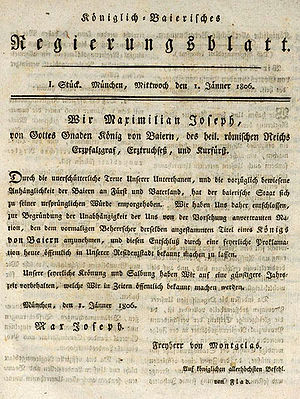
In Bavaria, the Agilolfings never rose above the rank of duke, even though they were able to fill their office at times in quasi-royal independence. Lombard chronicler Paulus Diaconus (died 799) does indeed give the names Garibald I and Tassilo I (died around 610) as "rex" (king), but elsewhere the same Tassilo as "dux" (duke), and the subordination of the two officials to the Frankish kings is obvious both in his work and in contemporary Frankish sources. That Tassilo III is said to have risen from dukedom to royal dignity is only a late medieval legend. Elector Maximilian IV Joseph's (ruled 1799-1825, from 1806 as King of Bavaria) reference in his proclamation as King of the "nation entrusted to us by providence" on 1 January 1806 to "the title of King of Bavaria ancestrally bestowed upon the former ruler of the same" was still based on this concept of history. At least a grandson of Duke Garibald I named Aripert (died 661) was elevated to Lombard king in 653, thus founding a dynasty that ruled the Kingdom of the Lombards for four generations until 712. Whether this branch of the family still regarded itself as Agilolfings remains uncertain though. Politically, the last king of this dynasty, Aripert II (ruled 701-712) was one of the opponents of the Bavarian dukes.
"Fake" Agilolfings
Since the 12th century, other alleged Agilolfings were "added" by imaginative interpretation and generous combining of sources, so that sometimes up to eight different dukes named Theodo were counted, while in reality there probably was no more than one, at best two. These fictions could be identified and eliminated by scientific source criticism in the 19th century. However, our knowledge of the family connections remains highly vague and incomplete. As a result, there are various speculations in literature, where one encounters alleged Agilolfings not only in Bavaria, but also in Alemania, on the Moselle, on the Middle Rhine, in Thuringia and in Saxony. There may well have been kinship connections to the Bavarian dukes; however, the self-conception of these people as Agilolfings is not tangible anywhere.
References
- Roman Deutinger, Das Zeitalter der Agilolfinger, in: Alois Schmid (Hg.), Handbuch der bayerischen Geschichte. Das alte Bayern. 1. Teil: Von der Vorgeschichte bis zum Hochmittelalter (Handbuch der bayerischen Geschichte 1/1), München 2017, 124-212.
- Roman Deutinger, Wer waren die Agilolfinger?, in: Steffen Patzold/Karl Ubl (Hg.), Verwandtschaft, Name und soziale Ordnung (300-1000), Berlin/New York 2014, 177-194.
- Carl I. Hammer, From ducatus to regnum. Ruling Bavaria under the Merovingians and Early Carolingians, Turnhout 2007.
- Jörg Jarnut, Agilolfingerstudien. Untersuchungen zur Geschichte einer adligen Familie im 6. und 7. Jahrhundert (Monographien zur Geschichte des Mittelalters 32), Stuttgart 1986.
- Britta Kägler, "Sage mir, wie du heißt". Spätantik-frühmittelalterliche Eliten in den Schriftquellen am Beispiel der frühen Agilolfinger, in: Hubert Fehr/Irmtraut Heitmeier (Hg.), Die Anfänge Bayerns. Von Raetien und Noricum zur frühmittelalterlichen Baiovaria, Sankt Ottilien 2012, 183-196.
- Friedrich Prinz, Die Agilolfinger. Bayerns erstes Herzogsgeschlecht, in: Alois Schmid/Katharina Weigand (Hg.), Die Herrscher Bayerns. 25 historische Portraits von Tassilo III. bis Ludwig III., München 2001, 13-28.
- Wilhelm Störmer, Das Herzogsgeschlecht der Agilolfinger, in: Hermann Dannheimer/Heinz Dopsch (Hg.), Die Bajuwaren. Von Severin bis Tassilo, München/Salzburg 1988, 141-152.
Sources
- Lex Baioariorum. Das Recht der Bayern, hg. u. übers. von Roman Deutinger (Editio Bavarica 3), Regensburg 2017.
- Paulus Diaconus, Historia Langobardorum, in: Monumenta Germaniae Historica. Scriptores rerum Langobardicarum, hg. von Ludwig Bethmann/Georg Waitz, Hannover 1878, 12-187.
- Fredegar, Chronicon, hg. von Bruno Krusch (Monumenta Germaniae Historica. Scriptores rerum Merovingicarum 2), Hannover 1888, 1-193.
- Annales Petaviani, in: Monumenta Germaniae Historica SS 1, hg. von Georg H. Pertz, Hannover 1826, 3-19.
Further Research
Related Articles
Cite
Roman Deutinger, Agilolfings, published 25 October 2018, english version published 27 April 2023; in: Historisches Lexikon Bayerns, URL: <https://www.historisches-lexikon-bayerns.de/Lexikon/EN:Agilolfings>(20.12.2025)
